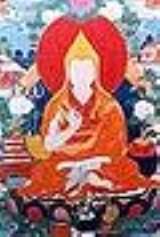
Trinley Gyatso, 12th Dalai Lama
Encyclopedia
Trinley Gyatso also spelled Trinle Gyatso and Thinle Gyatso, was the 12th Dalai Lama
of Tibet
.
His short life coincided with a time of major political unrest and wars among Tibet's neighbours. Tibet particularly suffered from the weakening of the Qing Dynasty
which had previously provided it with some support against the British Empire, which was aiming to influence Tibet as an expansion from its colonisation of India
.
He was recognised as a reincarnation of the Dalai Lama in 1858 and enthroned in 1860. During his period of training as a child, Tibet banned Europeans from entering the country because of wars Britain was fighting against Sikkim
and Bhutan
, both of whom were controlled to a considerable degree by the lamas in Lhasa
. These wars were seen as efforts to colonise Tibet - something seen as unacceptable by the lamas. Also, with missionaries threatening to enter Tibet via the Mekong and Salween
Rivers, Tibetans tried to emphasize the Qing Dynasty's authority over Tibet in the 1860s.
Trinley Gyatso was fully enthroned as Dalai Lama on 11 March 1873 but could not stamp his full authority on Tibet because he died of a mysterious illness on 25 April 1875.
Dalai Lama
The Dalai Lama is a high lama in the Gelug or "Yellow Hat" branch of Tibetan Buddhism. The name is a combination of the Mongolian word далай meaning "Ocean" and the Tibetan word bla-ma meaning "teacher"...
of Tibet
Tibet
Tibet is a plateau region in Asia, north-east of the Himalayas. It is the traditional homeland of the Tibetan people as well as some other ethnic groups such as Monpas, Qiang, and Lhobas, and is now also inhabited by considerable numbers of Han and Hui people...
.
His short life coincided with a time of major political unrest and wars among Tibet's neighbours. Tibet particularly suffered from the weakening of the Qing Dynasty
Qing Dynasty
The Qing Dynasty was the last dynasty of China, ruling from 1644 to 1912 with a brief, abortive restoration in 1917. It was preceded by the Ming Dynasty and followed by the Republic of China....
which had previously provided it with some support against the British Empire, which was aiming to influence Tibet as an expansion from its colonisation of India
India
India , officially the Republic of India , is a country in South Asia. It is the seventh-largest country by geographical area, the second-most populous country with over 1.2 billion people, and the most populous democracy in the world...
.
He was recognised as a reincarnation of the Dalai Lama in 1858 and enthroned in 1860. During his period of training as a child, Tibet banned Europeans from entering the country because of wars Britain was fighting against Sikkim
Sikkim
Sikkim is a landlocked Indian state nestled in the Himalayan mountains...
and Bhutan
Bhutan
Bhutan , officially the Kingdom of Bhutan, is a landlocked state in South Asia, located at the eastern end of the Himalayas and bordered to the south, east and west by the Republic of India and to the north by the People's Republic of China...
, both of whom were controlled to a considerable degree by the lamas in Lhasa
Lhasa
Lhasa is the administrative capital of the Tibet Autonomous Region in the People's Republic of China and the second most populous city on the Tibetan Plateau, after Xining. At an altitude of , Lhasa is one of the highest cities in the world...
. These wars were seen as efforts to colonise Tibet - something seen as unacceptable by the lamas. Also, with missionaries threatening to enter Tibet via the Mekong and Salween
Salween River
The Salween is a river, about long, that flows from the Tibetan Plateau into the Andaman Sea in Southeast Asia. It drains a narrow and mountainous watershed of that extends into the countries China, Burma and Thailand. Steep canyon walls line the swift, powerful and undammed Salween, one of the...
Rivers, Tibetans tried to emphasize the Qing Dynasty's authority over Tibet in the 1860s.
Trinley Gyatso was fully enthroned as Dalai Lama on 11 March 1873 but could not stamp his full authority on Tibet because he died of a mysterious illness on 25 April 1875.
- "During the period of the short-lived Dalai Lamas—from the Ninth to the Twelfth incarnations—the Panchen was the lama of the hour, filling the void left by the four Dalai Lamas who died in their youth."
Further reading
- Mullin, Glenn H. (2001). The Fourteen Dalai Lamas: A Sacred Legacy of Reincarnation, pp. 367–375. Clear Light Publishers. Santa Fe, New Mexico. ISBN 1-57416-092-3.

